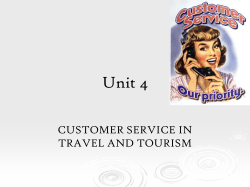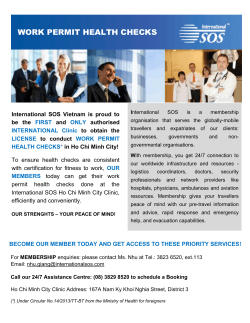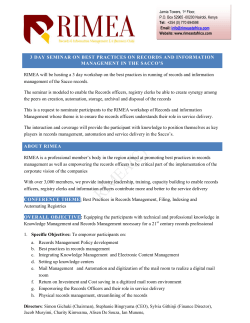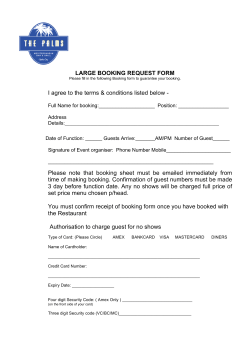
The Essential Asia Pacific Corporate Travel Handbook
Business Travel in Asia Pacific: Setting the Smart Course The Essential Asia Pacific Corporate Travel Handbook 3 Table of Contents Foreword 3 Executive summary 4 All roads lead to Asia Pacific 5 Technology drives change 7 Embracing change 8 Building policies for real people 9 1. Understand why and how people book travel 9 2. Consult with suppliers 10 3. Design a strict but flexible policy 11 4. Choose the right technology 12 5. Keep travellers safe and informed 14 6. Educate, inspire and enforce 15 4 Business Travel in Asia Pacific: Setting the Smart Course Foreword Few business activities engage people on such an emotive level as travel. At one end, it can be personal, exciting and rewarding. At the other end, it can be tiring, uncomfortable and daunting. Given that travel is typically the largest controllable expense for companies aer payroll and benefits, there is a risk of it being seen largely as a cost to be scrutinised, rather than an ally to be embraced. At Amadeus, we see the need to embrace the evolution of business travel as it grows at an unprecedented rate. By 2025, we expect corporate travel spending in Asia Pacific will have doubled and account for half of the world’s total. While China is set to lead this growth, we see a shi in corporate travel spending from traditional markets to other emerging nations such as India, Indonesia and Thailand. With this growth, we see profound changes in: • Technology, with an increase in online and mobile booking tools and a growing appetite for on-the-go travel management • Traveller behaviour, with more people relying on user generated content and mobile devices • Traveller expectations, with “duty of care” and the ability to combine work and pleasure trips becoming increasingly important The role of the corporate travel manager in Asia Pacific must also evolve – from transactional to consultative. Consultation has become the mantra and is the top priority for those looking to deliver a successful travel programme. So how does a corporate travel manager develop a programme that meets the changing needs of real people? Undoubtedly, technology is the primary ally. The value of the right guidance and expertise also cannot be overstated. With the data and insights from our research with Frost & Sullivan, The Essential Asia Pacific Corporate Travel Handbook from Amadeus outlines the steps companies can take to develop the most powerful travel programme and take full advantage of the opportunities. We look forward to working with you as a valued and valuable partner as you shape the future of your company’s travel success. Leon Herce Vice President, Distribution Commercial Amadeus Asia Pacific 5 Executive Summary “Our main challenge is educating employees to be responsible about booking” The regional head of travel management at a global soware company in India Asia’s corporate travel market is booming. Driven by China, India and the emerging economies of Southeast Asia, spending on business trips is expected to soar to $900 billion by 2025 from the current $400 billion. This world-leading growth presents opportunities, challenges and complexities for the travel industry and the companies that despatch their employees abroad. The cost-benefit balance is a major issue but the expectations of travellers are equally important as they use mobile technology on the fly and seek a collaborative approach from their employers about travel decisions. This essential handbook – developed jointly by Amadeus and Frost & Sullivan – brings together research from in-depth interviews with travel managers at multinational companies across a range of sectors in Australia, Hong Kong, India, Japan and Singapore. The researchers also interviewed corporate travel agents and 529 travellers who took business trips by air in the previous year and who work for a company with at least 250 employees and a corporate travel policy in place. The research shows that, to build efficiency and flexibility into their travel systems, companies must: • understand employee needs with regular consultations and big data • embrace the benefits that technology brings and develop online tools • build robust programmes that include suppliers and travellers • educate workers about compliance while allowing for real-world fluidity “The corporate travel manager is becoming a change manager,” a Hong Kong-based executive at a global chemical company told the researchers. “Consolidation makes it much easier to measure travel activity and see the results of policy changes. It is also increasingly important for employers with a duty of care to monitor and track their travellers.” Keeping costs under control is a key consideration for travel managers and companies in general as they seek to limit business class flights and encourage advance purchases of tickets. Using preferred suppliers and taking advantage of corporate discounts can help keep hotel bills in check. Getting lean and efficient means reviewing how the company does things internally, looking for ways to automate the process, analysing travel data and consolidating vendors. For companies riding Asia’s phenomenal growth in corporate travel, one thing is clear: Collaboration and planning are vital to staying agile, innovative and successful. 6 Business Travel in Asia Pacific: Setting the Smart Course All roads lead to Asia Pacific The Asia-Pacific region is the fastest-growing in the world for corporate travel. By 2025, corporate travel spending in Asia-Pacific will more than double to $900 billion from the current $400 billion and will make up half of the global total, forecasts by Amadeus show. This creates immense opportunities and formidable challenges for the travel sector and for corporate travel managers. Trade within the region is a key driver. We expect to see a dramatic shi in corporate travel spending from traditional markets such as Australia, Japan, Hong Kong and Singapore to emerging markets like China, India, Indonesia, Thailand, Malaysia and the Philippines. China is the juggernaut. By 2015, it will become the world’s largest corporate travel market, knocking the United States from the top spot. China now spends more than $250 billion each year on corporate travel and this is expected to double to $500 billion by 2025. Figure 1 Total business travel expenditure 2005-2023 Source: Amadeus, Oxford Economics 7 India is now a $25 billion corporate travel market and is expected to more than double to $60 billion by 2025. Asia’s mix of industries is diverse and diversifying. Agriculture, electronics, fast-moving consumer goods and infrastructure projects have now been complemented by financial services and mining as two of the fastest-growing sectors. The huge growth and evolving mix of markets and industries brings a greater complexity to travel. Organisations of all shapes and sizes must rethink corporate travel and build robust programmes to manage it. Figure 2 Asia Pacific corporate travel expenditure by country, 2012 to 2025 Source: Frost & Sullivan estimates. Others include Singapore, Indonesia, Thailand, etc. 8 Business Travel in Asia Pacific: Setting the Smart Course Technology drives change “We want to give employees more flexibility in making travel arrangements and improving productivity as employees will no longer have to go to a fixed internet location to manage their travel” The regional head of travel management at a global soware company in India Mobile technology is having a profound impact on corporate travel as workers taking trips now expect information to be at their fingertips – anytime and anywhere. having made a business travel booking on their mobile devices in the past 12 months. Indian travellers are most likely to be transacting on their devices (see Fig 3). The Asia-Pacific region has led the charge as global smart phone usage grew 25% from 2013 to 2014, with China now the largest smart phone market in the world and India set to knock the United States from second place by 2016 . Companies must embrace this shi and change the way they manage travel programmes by: In Asia, 90% of corporate travellers own a smartphone or tablet. More than half of these people use the devices to manage travel on the move, including destination research and booking management. Research is the most common activity for travellers using mobile devices on the road. But confidence in doing transactions is on the rise, with more than half • Adopting mobile tools for research, booking, changes and approvals • Using big data intelligently to understand traveller behaviour • Consulting travellers through satisfaction surveys • Using user-generated content to improve traveller interaction and buy in • Promoting duty of care and traveller communication tools Figure 3 Ownership of mobile devices and usage for business travel arrangements Figure 3 Ownership of mobile devices Source: Frost & Sullivan survey of 529 corporate travellers 9 Embracing change A collaborative company is much better positioned to be agile and innovative. Forward-thinking companies put the traveller at the centre of their travel programmes and transform the corporate travel manager from a transaction processor into a consultant. Companies must understand their overall travel ecosystem, which means looking at: • Why travellers are travelling • Who is travelling • How employees are booking their travel This knowledge will create savings, remove organisational roadblocks, ratify supplier selections and support the implementation of technology. Establishing a Travel Council within an organisation will allow for better coordination of the travel supply chain and approval process. This council should include key people from the Operations, Finance and Human Resources departments, including a number of frequent travellers, to ensure the travel programme is closely aligned with all areas of the business. “The corporate travel manager is becoming a change manager. We need to educate staff about travel policy and the reasons for it. Every day we get questions about travel policy. Many travellers don’t see the big picture as to why travel policies are in place. People are used to the old systems and see no need to change, so we increasingly need to make the case for change and assist in the change management process” Manager of travel management and procurement for Asia at a global chemical company in Hong Kong 10 Business Travel in Asia Pacific: Setting the Smart Course Building policies for real people To embrace the changes and opportunities of technology, to put employees at the heart of the travel programme and to realise the cost savings and efficiencies, companies must: • Understand why and how people book travel • Consult with suppliers • Design a strict but flexible policy • Choose the right technology • Keep travellers safe and informed • Educate, inspire and enforce 1. Understand why and how people book travel By analysing why employees are travelling, companies can evaluate the best options. With return on investment high on the agenda, the real value of travel needs to be measured and programmes aligned with corporate objectives. Travellers use a variety of channels to book corporate travel: airline websites, travel agencies, corporate online booking tools and their own mobile devices. But making bookings outside of the company travel policy does not allow for optimisation of that policy. While employees may have the best of intentions in believing they get better deals outside corporate booking channels, it affects the company’s ability to take advantage of negotiated rates and rebates. The real key to success is getting the booking data of your travellers and having a platform to consolidate, filter and interpret the information to lead to informed decisions. If used correctly, data helps companies to understand the savings and benefits of a streamlined booking and expense management solution that manages an entire trip. One integrated product can collate all data from trips that are combinations of air, rail and road – including the overall cost, travel time, carbon footprint, productivity etc. Mobile devices are indispensable companions for corporate travellers. Being able to manage travel with speed and ease is now an expectation, so companies must align this mobile behaviour with travel policy and processes. 11 2. Consult with suppliers In a competitive landscape, travel managers hold significant influence and can take advantage of this to secure the right support and service, while optimising their spending. Your approach to providers must include: • Involving the Travel Council to evaluate vendors and products • Auditing current technology to assess employee and management satisfaction • Selecting a preliminary set of vendors and solutions • Ensuring their vision and strategy meshes with your company • Conducting a full evaluation of each provider that encompasses financial health and stability, installation and integration support, training, maintenance agreements, upgrade policies, customer service, reputation and cost Many companies are clamping down on the use of business and first class air travel, but managing hotel vendors can be extremely difficult. Unlike airfares, hotel spending is largely le unmanaged despite its significant amount of the total travel bill. To address this, companies can concentrate hotel bookings with preferred suppliers, with participating hotels highlighted in the online booking tool. “Consolidation makes it much easier to measure travel activity and see the results of policy changes. It is also increasingly important for employers with a duty of care to monitor and track their travellers” Manager of travel management and procurement for Asia at a global chemical company in Hong Kong “There will be an increasing focus on managing hotel costs, which have oen tended to be ignored in favour of a focus on airlines. Hotel prices in some places can now be very high. This will tend to drive a greater focus on improving access to hotels through distribution systems such as GDS” Global Director of Account Management and Consulting at a travel management company in Australia 12 Business Travel in Asia Pacific: Setting the Smart Course “Policies have not gone back to pre-GFC (global financial crisis) levels. GFC travel policy is the new normal” Australia-based Head of Travel and Corporate Cards at a global bank “Our main challenge is educating employees to be responsible about booking. For example, the travel management consultant always gives three quotes for any itinerary but travellers do not always choose the cheapest (perhaps because they favour a particular airline).We are having to put more focus on control of travel behaviour” Manager of travel management and procurement for Asia at a global chemical company in Hong Kong 3. Design a strict but flexible policy The art of designing a robust travel policy is balancing control and flexibility. For multinational companies, the challenge is to adapt global policies and processes to local needs and conditions by understanding political, socio-cultural and operational nuances. In the Asia-Pacific region, 31% of corporate travellers indicated their employer was very strict about enforcing compliance. In the more mature markets of Australia, Japan and Singapore, compliance is more strictly enforced than in emerging markets such as India. Companies are seeking to reduce air travel costs through consolidating suppliers or policies such as advance purchase or lowest logical airfare. There is a clear move to less generous allowances. Just 35% of corporate travellers now routinely fly in first or business class, with 9% flying regularly on budget carriers for business. Australia leads the way with 14% of corporate travellers commonly using a budget carrier and only 15% flying business class. Conversely, Indian and Hong Kong corporate travellers are more likely to fly business or first class (56% and 43% respectively). None Singapore 1 Japan 2 3 India 4 5 or more Hong Kong Australia 0 20 40 60 80 100 Figure 4 Number of trips that went off plan* over 12 months for corporate travellers in Asia Pacific Source: Frost & Sullivan survey of 529 Asia Pacific corporate travellers * By 'off plan', it means not complying with corporate travel policy or exceeding allowance on hotel, tickets etc. 13 4. Choose the right technology Making the right technology choice can be complex. Corporate travellers expect personalised, streamlined and flexible journeys. They also expect to interact with technology in natural and intuitive ways as new tools break down the barriers within an organisation, giving travellers more control. The key here is to optimise the process to cover every step from pre-trip planning to post-trip expense reporting and reimbursement. This means providing a better traveller experience by: • Implementing an integrated travel & expense management tool • Improving automation and enhanced policy control within the booking tool • Consolidating data and using it to understand and respond to traveller needs Rolling out a solution requires ongoing technology support and client service, so the cost includes not only money but also time and frustration, training and maintenance, and forgone efficiencies and opportunities. Amadeus’ 2014 report “Cleared for take-off: Strategies “Over the past few years, we have rolled out an online booking tool which is used by all employees for point-to-point travel. This accounts for about 80% of trips. The tool was first used in Australia where it was reasonably well accepted but gaining user acceptance in Asia was more challenging as travellers were more used to using an intermediary. However, use of the tool is now fairly well accepted as users recognise the greater degree of control they have over the travel process” Travel Category Manager at a global bank in Singapore in Lean IT, and how they’re relevant to the travel business” urges travel businesses to adopt and apply the principles of lean thinking across all operations to understand and respond to the increasingly complex and changing needs of customers. By embracing lean, companies can attract new business, earn more revenues and better personalise offers to the needs of customers as individuals. Going lean means reviewing internal processes, identifying areas of automation, integrating improvements within existing applications, aligning processes, incorporating travel data analysis and consolidating vendors. These steps, incorporated into your strategic planning, help to contain travel spending and create an efficient, seamless travel process. User-generated content, such as traveller ratings and reviews, appeals to travellers’ thirst for information and the desire to have their opinions heard. Almost 80% of corporate travellers rate peer/ colleague recommendations as the most trusted source of advice, well ahead of online consumer reviews, editorial comments and travel provider advertising (Figure 6). Ed Figure 5 Most trusted sources of travel advice for corporate travellers Source: Frost & Sullivan survey of 529 corporate travellers 14 Business Travel in Asia Pacific: Setting the Smart Course More than half of corporate travellers across Asia Pacific now provide feedback on their trips via the internet or a corporate intranet site, particularly in Hong Kong and India (Figure 6). Companies with an effective user-generated content strategy can speed up the adoption of the self-booking tool and drive traffic to online and offline channels within the corporate travel policy. Figure 6 Corporate travellers who give travel feedback on internet or corporate intranet Source: Frost & Sullivan survey of 529 corporate travellers User-generated content helps companies build trust and compliance with employees and provides valuable information to the travel manager when negotiating with vendors. Mobile devices have evolved from voice and text communication tools into the interconnection for all aspects of business travel – from inspiration to booking, sharing, socialising and even managing expenses. This trend shows how critical it is for corporate travel management tools to be available beyond the traditional desktop environment. “Asian travellers are very familiar with using technology for leisure travel but corporate travel still lags behind. Consolidating multiple travel options onto mobile devices is challenging in Asia due to the fragmentation of the travel market. However, travellers do want the convenience of mobile devices to manage their travel and their use will continue to evolve” Global director of account management and consulting at a travel management company in Australia 15 5. Keep travellers safe and informed In many countries, companies have a responsibility to provide particular standards of duty of care to employees while they are on the move. Yet our research shows almost a quarter of corporate travellers in Asia say their employer has not adequately communicated their duty of care responsibility. Failing to implement a robust duty of care programme may result in unexpected and significant costs when responding to an employee emergency, not to mention potential legal issues and unhappy travellers. The travel management company can play an important role in building a duty of care programme, possibly working with the risk management vendor. A best practice duty of care programme includes: • A pre-trip assessment • Up-to-date intelligence on the destination • The ability to locate a traveller • Effective real-time communication tools. Consultation to support the integration of the programme is essential, particularly with departments such as Human Resources, Security and Risk. “In the quickly evolving travel sector, ‘duty of care’ remains paramount. Travel managers are increasingly looking towards integrated solutions as a ‘corporate duty of care and reporting tool’ to ensure the health, safety and welfare of their employees” Amadeus press release in August 2013 “Duty of care responsibilities are becoming more and more important. In some jurisdictions it can carry criminal liability. Ensuring duty of care in travel will become increasingly critical” Australia-based global head of travel and corporate cards at a global bank “As a chemical company, safety is the #1 priority and this extends to travel. We want to know where travellers are at all times. As an integral part of our duty of care we want to be able to contact travellers at all times” Manager of travel management and procurement for Asia at a global chemical company in Hong Kong 16 Business Travel in Asia Pacific: Setting the Smart Course 6. Educate, inspire and enforce The new breed of corporate traveller expects to be consulted and informed about all elements of the company travel programme and every aspect of their journey. This trust will cement a partnership that encourages travellers to stay within the policy. The relationship can be strengthened by providing mobile solutions, introducing resources like user-generated content and allowing employees to combine work and leisure travel. Consultation about negotiated savings, the benefits of an end-to-end online solution and the role of a duty of care programme can also build trust and compliance. It is important to engage internal stakeholders via regular communication, formal training, social media and other channels in order to: • Gather feedback from the road warriors (satisfaction surveys, user-generated content etc) • Understand travellers' changing needs • Emphasise travellers' responsibilities • Provide information about staying healthy and safe while travelling • Share guidelines, objectives, benefits and achievements of the travel programme 17 About Amadeus Amadeus is a leading provider of advanced technology solutions for the global travel industry. Customer groups include travel providers (e.g. airlines, hotels, rail and ferry operators, etc.), travel sellers (travel agencies and websites) and travel buyers (corporations and travel management companies). Our vision is to provide next generation travel technology that encourages collaboration amongst all players within the travel industry. To realise this we are investing in technology that will allow the seamless integration of content, data and systems whether they are hosted by Amadeus or connected through third parties. We are expanding our unique approach to corporate travel. By enhancing the technology solutions that span before, during and aer travel, the online booking tool is evolving beyond pure trip booking to deliver a total trip experience for corporate travellers. The move towards mobile technology is an integral part of our vision around the travel experience. Amadeus' corporate travel solution, Amadeus e-Travel Management (AeTM), helps corporations manage their global travel programmes more efficiently and cost-effectively. It helps business travellers plan, personalise and purchase their trip while remaining compliant with the global travel policy. Over 6,000 corporations worldwide utilise AeTM to integrate all the elements of their programmes into one intuitive and easy-to-administer solution. The Amadeus IT Group employs around 12,000 people worldwide across central sites in Madrid (corporate headquarters), Nice (development) and Erding (operations), as well as 71 local Amadeus Commercial Organisations globally. To find out more about Amadeus please visit www.amadeus.com or www.amadeus.com/blog for more on the travel industry. About Frost & Sullivan Frost & Sullivan enables clients to accelerate growth and achieve best-in-class positions in growth, innovation and leadership. The company’s Growth Partnership Service provides the CEO and the CEO’s Growth Team with disciplined research and best practice models to drive the generation, evaluation, and implementation of powerful growth strategies. We leverage 50 years of experience in partnering with Global 1000 companies, emerging businesses and the investment community from over 40 offices on six continents. For more information about Frost & Sullivan’s Growth Partnership Services, visit www.frost.com 18 Business Travel in Asia Pacific: Setting the Smart Course Notes © 2015 Amadeus Asia Limited
© Copyright 2025










